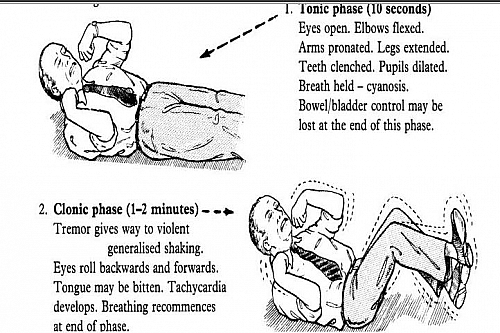Table of Contents
- Status Epilepticus Definition
- Status Epilepticus Causes (Precipitating Factors)
- Types of Status Epilepticus
- Status Epilepticus Symptoms and Signs
- Status Epilepticus Diagnosis
- Status Epilepticus Management Guidelines
- Status Epilepticus Treatment Guidelines (Treatment Protocol)
- Status Epilepticus Complications and Mortality Rate
Status Epilepticus Definition
Status Epilepticus is characterized by a series of seizures occurring without the patient regaining awareness between periods of attacks; it is a life threatening medical condition needs urgent intervention. Status Epilepticus presents with recurrent tonic clonic seizures (Major status) without regaining consciousness and it is different from Epilepsia partialis continua which is continuous seizure activity in one part of the body such as the finger or limb but without associated loss of consciousness. Status Epilepticus should be considered if prolonged serial seizures (two or more) occur with incomplete recovery of consciousness.
Status Epilepticus Causes (Precipitating Factors)
- Sudden withdrawal of anticonvulsant drugs or non-compliance with taking of drugs
- Metabolic disturbances
- Major structural lesions of the brain such as Stroke or tumors
- metabolic disturbance,
- Drug toxicity
- Refractory epilepsy
- CNS infection
- Head trauma
Types of Status Epilepticus
- Absence Status Epilepticus (Absence Status)
- Major Status Epilepticus (Major Status)
- Partial Motor Status Epilepticus (Partial Status)
- Complex Partial Status Epilepticus
Status Epilepticus Symptoms and Signs
Continuous tonic clonic contractions of muscles with associated loss of consciousness without regaining consciousness between attacks are the signs of Status epilepticus.
Status Epilepticus Diagnosis
Diagnosis is basically clinical but laboratory tests such as blood tests could help detect the precipitating factor. CT scanning may also reveal any brain lesion which could be the underlying cause of the status epilepticus.
Status Epilepticus Management Guidelines
Several treatment schedules exist but the most important issues includes the speed with which convulsive activity is treated, the accuracy of diagnosis and need for continued monitoring and cardiorespiratory support. An intensive care unit (ICU) is essential for effective treatment of patients with Status epilepticus.
Status Epilepticus Treatment Guidelines (Treatment Protocol)
- Give immediate Diazepam in a dose of 10 to 20 mg intravenously at 5mg/min and repeat once. If immediate I.V access is not possible, give diazepam or paraldehyde through the Rectal route
- You must admit the patient
- Administer oxygen and monitor ECG waves
- Take blood samples to check for blood alcohol levels, calcium, magnesium, drug screen, and anticonvulsant levels. Make sure you check the blood glucose level to exclude Hypoglycemia and treat if it is present
- If the nutrition is poor or in the case of suspected alcohol abuse, give Vitamin B1 (thiamine) intravenously in a dose of 250mg
- Give 4mg of i.v Lorazepam at 2 mg/min; Care should be taken as respiratory depression, hypotension and cardiac dysrhythmias may occur
- Reinstate previous anticonvulsant drugs and establish whether the patient has had adequate phenytoin recently. Measure levels as an emergency if service available.
- If seizures continue, consider giving i.v. Phenytoin or Fosphenytoin if these drugs have not been given earlier. For Phenytoin: give 15mg/kg intravenously by diluting to 10mg/mL in normal saline into a large vein at a rate of less than 50mg/min. For Fosphenytoin: this medication is a pro-drug of phenytoin and can be given faster than phenytoin; its doses are expressed in phenytoin equivalents (PE): such as 1.5mg of Fosphenytoin = 1mg phenytoin. Hence the dose of this can be given as follows: 15mg/kg (PE) which is (15mg x 1.5 = 22.5mg) is diluted to 10mg/mL in normal saline at 50-100mg (PE)/min.
- If status epilepticus continues, give 10 mg/kg of Phenobarbital diluted using 1 in 10 dilution in water for injection at a rate of less than 100mg/min. Instead of Phenobarbital, you could also use intravenous Clonazepam, Paraldehyde and Clomethiazole are also used
- If Status epilepticus still persists for more than 90minutes despite all of these measures mentioned above then use Thiopental or Propofol anesthesia with assisted ventilation
- EEG monitoring is valuable if there is doubt about the nature of status epilepticus
While treating Status epilepticus, take note of the fact that about 25% of apparent status may turn out to be Pseudostatus. Also of note is the potential unwanted effects of the drugs used in the treatment of status epilepticus such as hypotension and cardiac arrest, hence the need for continuous cardiorespiratory monitoring.
Status Epilepticus Complications and Mortality Rate
Status epilepticus has a mortality rate of 10 to 15% and over 50% of cases occur without a previous history of epilepsy. This means that about half of those who come down with Status epilepticus have never had it before. About 25% of patients with Status epilepticus having apparent refractory status may also have pseudostatus (non-epileptic attack disorder). The iatrogenic morbidity here is significant.

